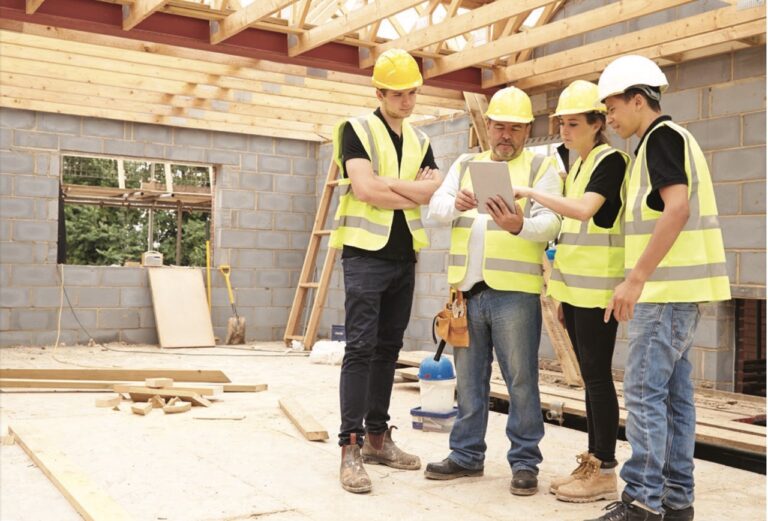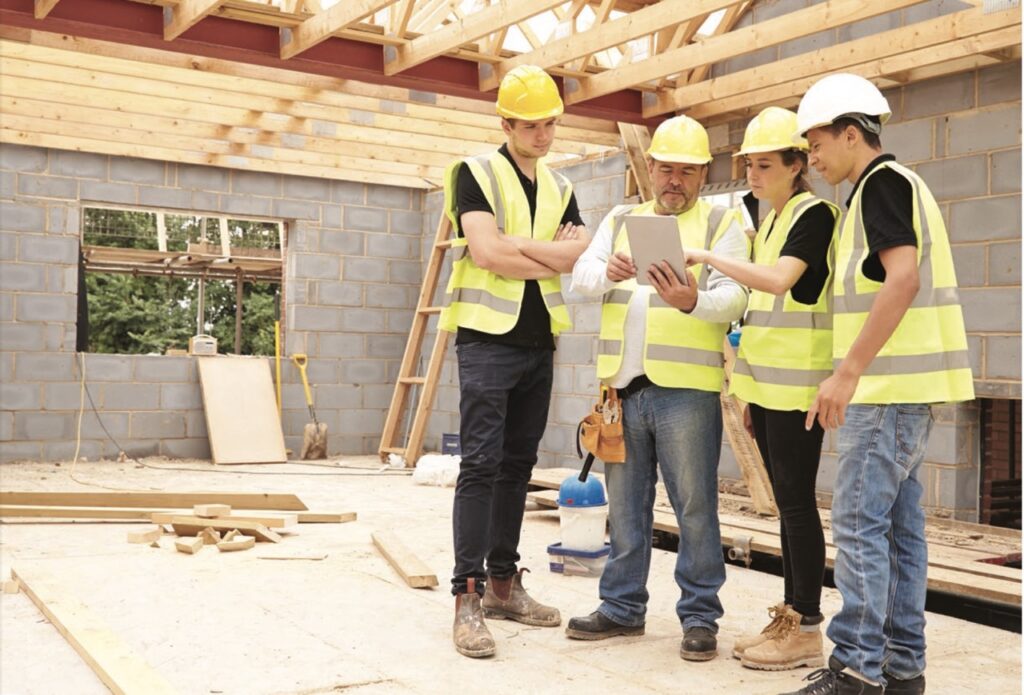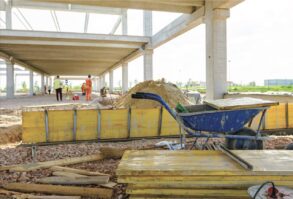SAFETY FIRST, SAFETY ALWAYS
Controlling workers’ compensation costs in the current environment
The focus of many construction companies’ safety policies and procedures has shifted somewhat
in recent years to the prevention of infectious disease. Nonetheless, physical safety mishaps continue to play a significant role in both rising workers’ compensation costs and lost revenues from project delays. The good news is you can gain some control over your jobsites and finances by implementing proven tactics for confronting safety challenges.
Room for improvement
A recent analysis by online industry publication Construction Dive found that the death toll in the construction industry has remained steady from 2011 to 2020, averaging 10 deaths out of every 100,000 workers. It’s a troubling lack of progress in improving overall safety, not to mention containing workers’ compensation costs.
Part of the stagnant numbers in recent years can be tracked to obstacles such as tougher compe- tition, shortages of labor and materials, inflation, and the pandemic. All of these have created pressure to minimize expenses, which can affect safety investments. Although short-sighted cuts are understandable in a crisis, they can have costly long-term implications.
3 ways to reduce risk
The 2022 “Safety Performance Report” published by Associated Builders and Contractors (ABC) suggests that proactive safety practices can reduce recordable incidents by up to 84%. Here are some tips for taking an appropriately aggres- sive stance on safety:
1. Conduct continuous, comprehensive and cur- rent safety training. Many construction companies have had to hire inexperienced workers, greatly increasing the risk of accident and injury. According to ABC, though, businesses that do an “in-depth indoctrination” of new employees on safety systems and processes have 70% lower total recordable incident rates (TRIR) and 72% lower days away and restricted or transferred (DART) rates.
Training shouldn’t be limited to new employees. Hold “toolbox talks,” open discussions about safety incidents and strategies, as often as possi- ble. ABC reports that construction companies that conduct daily toolbox talks reduce TRIR by 76% and DART rates by 79% compared with businesses that hold them only monthly.
Regularly review and revise your training to keep up with evolving risks. For example, as mentioned, many construction companies have recently added specific protocols regarding infectious disease. You also might want to update your training when OSHA rolls out new National Emphasis Programs.
WHY YOU NEED TO MONITOR YOUR X-MOD CLOSELY
As you’re no doubt aware, insurers use an experience modification (X-Mod) factor to adjust workers’ compensation premiums for construction companies and other types of businesses. It’s based on your actual and expected costs of injuries. If your number is higher than the X-Mod for the industry, you’ll probably have to pay higher premiums, cutting into your profits.
Don’t assume that your construction company’s X-Mod is completely accurate. The factor is calculated using data from several sources, including the workers’ compensation insurance provider, the employer and, where applicable, third-party payroll companies. It’s worth checking the numbers provided by the external sources.
For example, check with your insurance agent to confirm that the amounts actually paid for employee claims align with the amounts the insurer conveys to the reporting bureaus. Sometimes agents don’t have up-to-date, accurate information on the status of a case, including the employee’s treatments and return to work. In other instances, an agent might incorrectly believe a closed case remains open. The potential result is a miscalculation that leads to an inaccurate X-Mod factor and a subsequent increase in your insurance costs.
2. Support employees who are recovering and help them get back to work. You can reduce workers’ compensation costs by encouraging injured or ill employees to receive immediate and ongoing medical attention appropriate to their conditions. Doing so will help them recover sooner and avoid unnecessary treatment costs.
Don’t leave getting workers back on the job to an ad hoc process. A formal return-to-work (RTW) program will reduce your need to recruit and train replacement workers or pay overtime to employees filling in for those on leave. It also better prepares you to find positions suitable for employees with medical restrictions, so they can rejoin the team and contribute in some way as soon as possible.
Above all, a supportive RTW program is good for employee morale and the bottom line. By offering one, you’re demonstrating to your workforce that you’re actively engaged in helping them get and stay healthy.
3. Cultivate a culture of safety. Company leaders must not only routinely communicate that safety is a priority, but also walk the walk. Workers notice, for instance, whether managers and supervisors follow the safety rules themselves or cut corners.
They take heed, as well, when you provide top- notch personal protection equipment and not just the bare minimum.
In addition, you should facilitate the easy report- ing of incidents, hazards and risky behaviors — perhaps anonymously. It’s critical, though, that you act promptly to address reports and publicize responses so employees know that you’re taking their concerns seriously.
You can increase employees’ investment in safety by giving them a voice. For example, appoint worker representatives to a safety committee and include their input when formulating policies and procedures as well as reviewing accidents and near-misses. You’ll likely find employees are aware of risks that managers aren’t.
An ongoing responsibility
Most construction businesses constantly face tough competition and an ever-shifting variety
of industry pressures (inflation, supply shortages, lack of skilled labor) that can make it difficult to prioritize safety. But your commitment should never waver. A company that operates safely stands a much better chance of completing quality work on time — and enjoying the profits that result.
IS IT TIME TO FORMALIZE YOUR SUBCONTRACTOR PREQUALIFICATION PROCESS?
If you’re a general contractor, you know all too well that your com- pany’s success is largely predicated on your ability to identify and deploy trustworthy subcontractors. Some construction business owners keep a list of preferred subcontractors in their heads. However, many others eventually realize the risk of choosing poorly is too great and decide to for- malize the prequalification process.
Leadership, safety, capacity
There isn’t one right way to prequalify subcontrac- tors. What information you should obtain depends, in part, on the nature of your business and the size and complexity of your projects. The most important thing is to gather, organize and analyze the data consistently.
A good starting place is with each company’s ownership and management team. Look at how long its leadership has been in place and the backgrounds of
those in charge. Has the business ever been terminated for nonper- formance or walked off a job? Has the company or any of its owners ever filed for bankruptcy? Does it or any of its owners or executives have a history of litigation, either as the defendant or plaintiff?
Also, dig into the company’s safety record. What’s its Workers’ Comp Experience Modification Rating? Does it have a history of OSHA violations?
Naturally, it’s also critical to ensure that a sub- contractor has the skills and experience for your typical projects. Ask each business to submit a list of recent jobs, including a description of the work and size of the subcontract. Request references from other general contractors, as well as custom- ers, lenders, sureties and suppliers. You might even ask to visit one or two of a subcontractor’s jobsites to examine the quality of work firsthand.
There’s also the question of capacity. Even if the company has a solid history, it could very well be short-staffed in the current environment. Ask about the size and skills of the subcontractor’s workforce, as well as for a list of current and upcoming proj- ects. This information, together with a brief history of recently completed jobs, should give you a good idea of the business’s capacity to take on additional projects.
In addition, you might want to inquire about the company’s current equipment and technology holdings to determine whether it has the assets needed to efficiently perform on your jobs.
Financial stability is key
A separate and essential part of the prequalifi- cation process is financial stability. Many general contractors ask subcontractors to submit their most recent set of financial statements.
Ask each business to submit a list of recent jobs, including a description of the work and size of the subcontract.
Obviously, these documents will reveal many insights. For example, you can see whether
the financial statements conform to Generally Accepted Accounting Principles, which is definitely preferred. You can also check to see if the state- ments were prepared and/or audited under the guidance of a CPA with construction experience.
To truly gauge a subcontractor’s solvency, use the financial statements to calculate at least a few key metrics, such as current ratio and debt- to-equity ratio. Pay particular attention to whether a subcontractor has enough cash to keep its business going, and that its accounts receivable are appropriate to its income level. Make sure the owners are maintaining sufficient equity in the company.
Ways to formalize
Of course, gathering data is one thing; organiz- ing it into a functional format is quite another. Ideally, you’ll want to generate a set of forms, questionnaires and checklists for prequalifying subcontractors.
If that sounds overwhelming, assistance is avail- able. Some vendors offer prequalification software that helps streamline and automate the process. Another option is to ask your surety whether it will prequalify subcontractors on your behalf. One advantage of this approach is that subcontractors may be more comfortable sharing financial state- ments and other information with a surety than a general contractor.
A worthy effort
There’s no doubt that formally prequalifying subcontractors can present great administrative and analytical challenges. But the result is often well worth it. Your CPA can help you decide what information to ask for and how to best analyze the financial data involved.
HOW BLOCKCHAIN COULD CHANGE CONSTRUCTION
As cryptocurrency-based investments grow, blockchain is becoming an increasingly hot topic in many indus- tries. Could this technology eventually find its way to construction — namely in the way contracts are executed? Indeed, it could.
Many people have heard of the cryptocurrency called Bitcoin, but the second-most popular digital currency is Ether. In September 2022, the blockchain-based platform on which Ether is used, Ethereum, underwent an upgrade that makes the cryptocurrency even cheaper and faster to use than Bitcoin. This upgrade is helping make the mechanics of cryptocurrency even more economical and feasible for many industries.
Defining blockchain
Although the technology behind blockchain is sophisticated, the concept is simple: It’s a shared database — or “digital ledger” — that’s continuously copied, updated and synchro- nized on thousands or even millions of computers maintained by various third parties.
This lack of centralized storage or control makes it extremely difficult for anyone to hack into or tamper with the database/ledger, which can accept new transactions only if they’re verified by these third par- ties through established consensus protocols. In simpler terms, block- chain allows users to securely share validated, immutable records.
Creating “smart” contracts
A blockchain records transfers, but it also contains self-executing agreements that auto- matically take place when certain conditions are met. Does that sound like a contract? It could very well be. In construction, for example, a project- specific blockchain could be restricted to only certified contractors and be voided if specified time, progress or delivery requirements aren’t met.
Blockchain allows users to securely share validated, immutable records.
Using a blockchain to create a construction contract would keep all parties on the same page. The technology eliminates confusion by maintaining only one version of the contract, which is virtually impossible to modify without triggering alarms. If a change or correction is needed, it can be added to the blockchain only after appropriate explanations and supporting documentation are submitted and approved, creating a permanent audit trail.
What’s more, there could be significant advan- tages to combining a subset of contractual details into the very currency used for payment. Consider a construction company’s vendor agreement for building supplies. The vendor could attach radio- frequency identification tags to materials as they’re shipped, allowing parties to track their movement.
Once the materials have been delivered to a jobsite, inspected and approved using a digital signature, the smart contract would determine whether the vendor has delivered the materials on time and met any other contractual terms. If so, the system would initiate an electronic payment to the vendor. If the vendor fails to meet contractual requirements, the smart contract documents this fact, alerts the parties and could even track the delay’s impact on related construction activities.
Keeping tabs on the trend
Whether the construction industry will adopt blockchain-based contracts on a widespread basis remains to be seen. If several large and reputable infrastructure owners adopt a crypto- currency to strengthen assurance of project prog- ress, we could see a domino effect. Construction companies will be incentivized to accept the digital currency so they can win those jobs, and their subcontractors and suppliers will, in turn, also have a major incentive to use the digital currency. Whatever the future may hold, block- chain is an evolving technology trend well worth keeping tabs on.
KNOW WHAT YOU’RE GETTING INTO WITH AN IDIQ CONTRACT
In federal contracting, an indefinite delivery, indefinite quantity (IDIQ) contract provides for the delivery of an unspecified quantity of supplies or services during a fixed period.
As the saying goes, “It’s good work if you can get it.” This type of contract ensures a relatively long-term revenue stream — generally up to five years — from a dependable payer. However, there are challenges to consider.
A flexible approach
Various federal agencies use IDIQ construction contracts to secure a contractor for an undefined number of projects. It’s an appealing approach for an agency with ongoing or to-be-determined construction needs that fall within the parameters of the contract.
Leveraging one construction company for multiple projects helps to create a cohesive, nimble project team with an established working relationship. The agency can not only engage the winning con- struction business to work on a funded project, but also consult regularly with that contractor on other jobs as funding and approvals become available. Plus, having an umbrella contract in place gener- ally enables earlier starts for emergency repair and con- struction work.
You might also encounter other entities soliciting bids for IDIQ contracts. These can include state agencies and nonprofit organizations.
What to know and do
First and foremost, bear in mind that IDIQ contracts typically require contractors to mobilize quickly and execute fast-paced small to midsize projects. Here are a few tips on completing such jobs on time and within budget:
Clearly define the client’s goals. Take time to fully understand your client’s mission and strate- gic objectives. Be prepared to advise them on whether and how the various projects that come up will indeed help them meet those goals.
Establish a single point of contact. Assign a well- trained and preferably experienced project man- ager as the client’s primary contact. This individual must be able to react quickly, troubleshoot issues as they arise, understand budget constraints and approach projects with a sense of urgency.
Implement scalable technology. To operate efficiently, make sure your tech tools (hardware, software and mobile apps) can readily adapt to jobs of various sizes. If necessary, build your team’s comfort level with technology and strive to be an early adopter of new products.
Develop trusted relationships with subcontractors and suppliers. There’s no time for delays on IDIQ projects. Prequalify subcontractors who can provide services as needed. Identify suppliers that you know will carry the right materials and deliver them on time.
A long-term relationship
IDIQ contracts are poten- tially lucrative. But you’ve got to know what you’re signing up for. If you win the bid, you’ll be entering into a long-term client relationship that will call for frequent contact and quick responsiveness.




